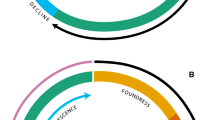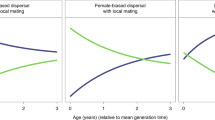Abstract
Kinship plays a fundamental role in the origin of social life. It is also predicted to affect numerous details within animal societies, yet recent studies revealed equivocal results. We tested the influence of relatedness for the occurrence of workers in the termite Cryptotermes secundus. Here individuals are developmentally flexible to remain workers or to become dispersing sexuals that found new colonies. Furthermore, colony relatedness naturally increases with inbreeding and decreases when neighboring colonies fuse. Similar to recent studies on social Hymenoptera, our experimental change in relatedness gave equivocal results. Reducing relatedness within colonies did not have an effect, but individuals in inbred colonies were less likely to disperse and more likely to remain workers as predicted by kinship arguments. Several explanations for the interpretation of these equivocal results are provided.


Similar content being viewed by others
References
Abe T (1987) Evolution of life types in termites. In: Kawano S, Connell JH, Hidaka T (eds) Evolution and coadaptation in biotic communities. University of Tokyo Press, Tokyo
Atkinson L, Adams ES (1997) The origins and relatedness of multiple reproductives in colonies of the termite Nasutitermes corniger. Proc R Soc Lond B 264:1131–1136
Beekman M, Ratnieks FLW (2003) Power over reproduction in social Hymenoptera. Philos Trans R Soc Lond B Biol Sci 358:1741–1754
Benjamini Y, Hochberg Y (1995) Controlling the false discovery rate: a practical and powerful approach to multiple testing. J R Stat Soc B 57:289–300
Boomsma JJ, Nielsen J, Sundström L et al (2003) Informational constraints on optimal sex allocation in ants. Proc Natl Acad Sci USA 100:8799–8804
Bourke AFG, Franks NR (1995) Social evolution in ants. Princeton University Press, Princeton
Brown WD, Keller L (2000) Colony sex ratios vary with queen number but not relatedness asymmetry in the ant Formica exsecta. Proc R Soc Lond B 267:1751–1757
Bulmer MS, Eldridge SA, Traniello JFA (2001) Variation in colony structure in the subterranean termite Reticulitermes flavipes. Behav Ecol Sociobiol 49:236–243
Colegrave N, Ruxton GD (2003) Confidence intervals are a more useful complement to nonsignificant tests than are power calculations. Behav Ecol 14:446–447
Crozier RH, Pamilo P (1996) Evolution of social insect colonies: sex allocation and kin selection. Oxford University Press, Oxford
DeHeer CJ, Vargo EL (2004) Colony genetic organization and colony fusion in the termite Reticulitermes flavipes as revealed by foraging patterns over time and space. Mol Ecol 13:431–441
Foster KR, Wenseleers T, Ratnieks FLW (2006) Kin selection is the key to altruism. Trends Ecol Evol 21:57–60
Frank SA (1998) Foundations of social evolution. Princeton University Press, Princeton
Fuchs A, Heinze J, Reber-Funk C, Korb J (2003) Isolation and characterization of six microsatellite loci in the drywood termite Cryptotermes secundus (Kalotermitidae). Mol Ecol Notes 3:355–357
Garcia LV (2004) Escaping the Bonferroni iron claw in ecological studies. Oikos 105:657–663
Goodisman MAD, Crozier RH (2002) Population and colony genetic structure of the primitive termite Mastotermes darwiniensis. Evolution 56:70–83
Griffin AS, West SA (2003) Kin discrimination and the benefit of helping in cooperatively breeding vertebrates. Science 302:634–636
Gross MR (1996) Alternative reproductive strategies and tactics: diversity within sexes. Trends Ecol Evol 11:92–98
Hammond RL, Bruford MW, Bourke AFG (2003) Male parentage does not vary with colony kin structure in a multiple-queen ant. J Evol Biol 16:446–455
Hoenig JM, Heisey DM (2001) The abuse of power: the pervasive fallacy of power calculations for data analysis. Am Stat 55:19–24
Husseneder C, Brandl R, Epplen J, Kaib M (1999) Within colony relatedness in a termite species: genetic roads to eusociality? Behaviour 136:1045–1063
Keller L (1997) Indiscriminate altruism: unduly nice parents and siblings. Trends Ecol Evol 12:99–103
Korb J (2005) Regulation of sexual development in termites: mutilation, pheromonal manipulation or honest signal. Naturwissenschaften 92:45–49
Korb J (2006) Limited food induces nepotism in drywood termites. Biol Lett 2:364–366
Korb J (2007) Termites: an alternative road to eusociality and the importance of group benefits in social insects. In: Gadau J, Fewell J (eds) Organization of insect societies. Harvard University Press, Harvard (in press)
Korb J, Heinze J (2004) Multilevel selection and social evolution of insect societies. Naturwissenschaften 91:291–304
Korb J, Katrantzis S (2004) Influence of environmental conditions on the expression of the worker phenotype in a lower termite: implications for the evolution of workers in termites. Evol Dev 6:342–352
Korb J, Lenz M (2004) Reproductive decision-making in the termite Cryptotermes secundus (Kalotermitidae) under variable food conditions. Behav Ecol 15:390–395
Korb J, Schmidinger S (2004) Help or disperse? Cooperation in termites influenced by food conditions. Behav Ecol Sociobiol 56:89–95
Lenz M (1994) Food resources, colony growth and caste development in wood-feeding termites. In: Hunt J, Nalepa CA (eds) Nourishment and evolution in insect societies. Westview, Boulder
Myles TG (1988) Resource inheritance in social evolution from termites to man. In: Slobodchikoff CN (ed) The ecology of social behavior. Academic, New York
Norusis M (1993) SPSS for Window. Base systems. SPSS Inc., Chicago
Nutting WL (1969) Flight and colony foundation. In: Krishna K, Weesner F (eds) Biology of termites I. Academic, New York
Page RE, Robinson GE, Fondrk MK (1989) Genetic specialists, kin recognition and nepotism in honey-bee colonies. Nature 338:576–579
Queller DC (1993) Genetic relatedness in viscous populations. Evol Ecol 8:70–73
Ratnieks FLW, Reeve HK (1992) Conflict in single-queen Hymenopteran societies: the structure of conflict and processes that reduce conflict in advanced eusocial species. J Theor Biol 158:33–65
Reeve HK (1998) Game theory, reproductive skew, and nepotism. In: Dugatkin RH (ed) Theory and animal behaviour. Oxford University Press, Oxford
Roisin Y (2000) Diversity and evolution of caste patterns. In: Abe T, Bignell D, Higashi M (eds) Termites: evolution, sociality, symbioses, ecology. Kluwer Academic Publishers, Dordrecht
Roux E (2004) Evolution of eusociality and the soldier caste: a case study in a drywood termite. Dissertation, University of Regensburg
Shellman-Reeve JS (1997) The spectrum of eusociality in termites. In: Choe J, Crespi B (eds) The evolution of social behaviour in insects and arachnids. Cambridge University Press, Cambridge
Shellman-Reeve JS (2001) Genetic relatedness and partner preference in a monogamous, wood-dwelling termite. Anim Behav 61:869–876
Thompson G, Hebert P (1998) Population genetic structure of the neotropical termite Nasutitermes nigriceps (Isoptera: Termitidae). Heredity 8:48–55
Thorne BL (1997) Evolution of eusociality in termites. Annu Rev Ecol Syst 28:27–54
Thorne BL, Traniello J (2003) Comparative social biology of basal taxa of ants and termites. Annu Rev Entomol 48:283–306
Thorne BL, Breisch NL, Muscedere ML (2003) Evolution of eusociality and the soldier caste in termites: influence of intraspecific competition and accelerated inheritance. Proc Natl Acad Sci USA 100:12808–12813
Vargo EL (2003) Hierarchical analysis of colony and population genetic structure of the eastern subterranean termite, Reticulitermes flavipes, using two classes of molecular markers. Evolution 57:2805–2818
West SA, Pen I, Griffin AS (2002) Cooperation and competition between relatives. Science 296:72–75
Acknowledgments
We wish to thank S. Schmidinger, S. Kirschner for help with data collection, K. Boomsma and two anonymous referees for helpful comments on the manuscript, and M. Lenz for substantial support in Australia. The project was supported by the German Science Foundation (KO 1895/2-1). Environment Australia gave permission to export the termites (export permit no. PWS P20011508). The experiments performed comply with the current laws in Australia and Germany where the experiments were performed.
Author information
Authors and Affiliations
Corresponding author
Rights and permissions
About this article
Cite this article
Korb, J., Schneider, K. Does kin structure explain the occurrence of workers in a lower termite?. Evol Ecol 21, 817–828 (2007). https://doi.org/10.1007/s10682-006-9153-5
Received:
Accepted:
Published:
Issue Date:
DOI: https://doi.org/10.1007/s10682-006-9153-5




